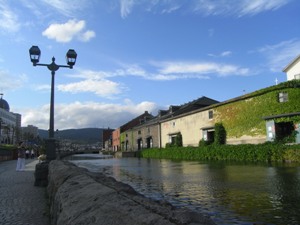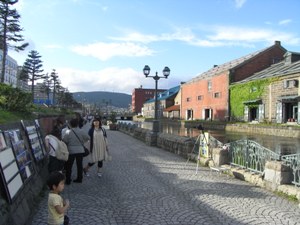
The Asian River Restoration Network was established in Nov. 2006 to support the exchange of information relating to environmental restoration of rivers and watersheds. JRRN has a role of ARRN secretariat currently.
Go to ARRN website

< World's WATERFRONT:JAPAN Category: History and traditional restoration >
Ishii Flume was constructed to secure the household water supply in Saga castle town and the agricultural water supply in Saga Plain in the Edo Period approximately 400 years ago, when people frequently suffered from droughts and water supply stoppages.
Over a period of approximately 350 years from that time until 1960 when Kawakami head works were constructed upstream, it had been used as a water utilization facility. In 1963 it was damaged by a great flood.
Later, a historical waterfront improvement project was started in Ishii Flume area through collaboration between Saga Prefecture, Saga City, Yamato Town and Ministry of Land, Infrastructure, Transport and Tourism.
Today, activities are being conducted under the theme of "the water flow of the homeland toward tomorrow again" to hand the important river civil engineering technology on to future generations, learn the history of Saga's water and land development and create an local community base where people can enjoy Kase River waterfront environment with rich nature by conserving, regenerating and utilizing Ishii Flume, a valuable cultural heritage.
By JRRN-secre | Category: History and traditional restoration,Kyushu | Comment(0) | Trackback(0) |
Date: 2010.09.10 18:47
Yanta River is a class A river flowing from the mountainous area of Saigo Village of Fukushima Prefecture and joining Abukuma River. It runs east and west through the south part of Shirakawa City.
Since it was designated as a target river of the homeland river restoration project, efforts have been made for the river restoration for water control and environmental improvement around the river from the viewpoint of urban development.
Yanta River was largely damaged by concentrated heavy rain in August 1998. After that a "special emergency project against serious river disasters" was carried out. As a result of the promotion of a river restoration project called "the homeland river restoration project" under the theme of "The Yanta River, a clean stream with history and atmosphere", the local community has been vitalized and the natural environment conserved.
By JRRN-secre | Category: History and traditional restoration,Tohoku | Comment(0) | Trackback(0) |
Date: 2010.09.10 18:43
|
Current condition(Photo by Michiya Tannai, Aug. 2009)
|
Otaru Canal was completed in 1923 as a port facility. As it was constructed by reclaiming offshore other than by digging inland, it is characterized by a gently-curved shape in a fan-like form other than a straight-line shape. It played the important role of loading and unloading cargoes between ships berthed in the port and warehouses. However, in postwar days, the mission was ended because the pier of the port was constructed.
In 1986, after the controversy as to whether to reclaim it or not over ten-odd years, part of it was reclaimed, half of the canal in width was changed into a road and walkways and parks were constructed. In this way Otaru Canal was regenerated into the present form. In the walkways, 63 gas lamps were built and the stone warehouses along the canal were conserved as they were. At nightfall gas lamps are lit and the stone warehouses are lit up and an atmosphere different from that in the daytime can be seen.
By JRRN-secre | Category: History and traditional restoration,Hokkaido | Comment(0) | Trackback(0) |
Date: 2010.09.10 18:42
Shimabara City, which is likened to a small Kyoto surrounded by rich nature of the sea and the mountains, was called "a lagoon city" from old times because water cultivated by the Unzen mountain chain sprang out in many places in the city. However, Shimabara was greatly damaged by the eruption of Mount Unzen-Fugen. Since then, the reconstruction of the city has been promoted by attaching weight to "water".
Urban development under the theme of "water" was started and pocket parks, public drinking fountains, ponds, objet d'art, etc. have been constructed. Today, efforts are made to secure good landscapes and pleasant and comfortable pedestrian traffic lines and form attractive urban centers to collect visitors by improving the facilities using springs seen in various locations in the city through the Shimabara City spring network improvement project.
Shimabara Spring won the "Handmade Homeland Award" and was selected as one of the 100 water hometowns and 100 famous waters.
By JRRN-secre | Category: History and traditional restoration,Kyushu | Comment(0) | Trackback(0) |
Date: 2010.09.10 18:39
Nishikawa Channel and its tributary Edagawa Channel take the water from Asahi River as the Asahi River joint canal, running southward through the center of Okayama City. They provide irrigation water for the paddy field spread in the south of the city. On either side of these canals, a water amenity park containing walkways, summerhouses, corridors over the waterway, etc. was constructed. It is popular among citizens as an esplanade.
In the Nishikawaryokudo, people enjoy the firefly canal created by dividing the water, a wind-up doll using a waterwheel, a cascade and a terrace over the water. In the Edagawaryokudo, a calm space is provided, where stones produced in Okayama Prefecture are positioned in a Japanese garden style.
Nishikawa Canal was designated as one of the best 100 canals in Japan.
By JRRN-secre | Category: History and traditional restoration,Chugoku | Comment(0) | Trackback(0) |
Date: 2010.09.10 18:36
Kuratsuki Channel is a waterway 1,500 m in total length running from the center of Kanazawa City, Ishikawa Prefecture to the northwest area. In ancient times, it was used for irrigation and fire prevention for the castle and as the motive energy of the waterwheel to squeeze canola oil. Even today the rural area extending from the center of Kanazawa City to the northwest part is irrigated by this canal. In the urban area, it is used as water for fire prevention and for agriculture downstream.
In 1993, the channel was partially opened and a pocket park was constructed in the neighborhood of Kakinokibatake and in 1999 it was opened in the district between Korinbo and Takaoka Town. This helped to create a pleasant and lively atmosphere in the central urban area. Kuratsuki Channel was designated as one of the 100 best canals in Japan.
By JRRN-secre | Category: History and traditional restoration,Hokuriku | Comment(0) | Trackback(0) |
Date: 2010.09.10 18:32
<< Previous |







